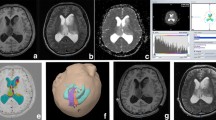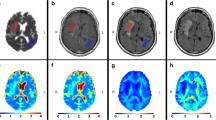Abstract
Introduction
In this work, we aim to assess the significance of diffusion tensor imaging (DTI) and diffusion kurtosis imaging (DKI) parameters in grading gliomas.
Methods
Retrospective studies were performed on 53 subjects with gliomas belonging to WHO grade II (n = 19), grade III (n = 20) and grade IV (n = 14). Expert marked regions of interest (ROIs) covering the tumour on T2-weighted images. Statistical texture measures such as entropy and busyness calculated over ROIs on diffusion parametric maps were used to assess the tumour heterogeneity. Additionally, we propose a volume heterogeneity index derived from cross correlation (CC) analysis as a tool for grading gliomas. The texture measures were compared between grades by performing the Mann-Whitney test followed by receiver operating characteristic (ROC) analysis for evaluating diagnostic accuracy.
Results
Entropy, busyness and volume heterogeneity index for all diffusion parameters except fractional anisotropy and anisotropy of kurtosis showed significant differences between grades. The Mann-Whitney test on mean diffusivity (MD), among DTI parameters, resulted in the highest discriminability with values of P = 0.029 (0.0421) for grade II vs. III and P = 0.0312 (0.0415) for III vs. IV for entropy (busyness). In DKI, mean kurtosis (MK) showed the highest discriminability, P = 0.018 (0.038) for grade II vs. III and P = 0.022 (0.04) for III vs. IV for entropy (busyness). Results of CC analysis illustrate the existence of homogeneity in volume (uniformity across slices) for lower grades, as compared to higher grades. Hypothesis testing performed on volume heterogeneity index showed P values of 0.0002 (0.0001) and 0.0003 (0.0003) between grades II vs. III and III vs. IV, respectively, for MD (MK).
Conclusion
In summary, the studies demonstrated great potential towards automating grading gliomas by employing tumour heterogeneity measures on DTI and DKI parameters.







Similar content being viewed by others
References
Louis DN, Ohgaki H, Wiestler OD, Cavenee WK, Burger PC, Jouvet A, Scheithauer BW, Paul Kleihues P (2007) The 2007 WHO classification of tumours of the central nervous system. Acta Neuropathol 114(2):97–109
Van Cauter S, De Keyzer F, Sima DM, Sava AC, D’Arco F, Veraart J, Peeters RR, Leemans A, Van Gool S, Wilms G, Demaerel P (2014) Integrating diffusion kurtosis imaging, dynamic susceptibility-weighted contrast-enhanced MRI, and short echo time chemical shift imaging for grading gliomas. Neuro-Oncology 16(7):1010–1021
Inoue T, Ogasawara K, Beppu T, Ogawa A, Kabasawa H (2005) Diffusion tensor imaging for preoperative evaluation of tumor grade in gliomas. Clin Neurol Neurosurg 107(3):174–180
Sugahara T, Korogi Y, Kochi M, Ikushima I, Shigematu Y, Hirai T, Okuda T, Liang L, Ge Y, Komohara Y, Ushio Y (1999) Usefulness of diffusion weighted MRI with echo planar technique in the evaluation of cellularity in gliomas. J Magn Reson Imaging 9(1):53–60
Murakami R, Hirai T, Kitajima M, Fukuoka H, Toya R, Nakamura H, Kuratsu J, Yamashita Y (2008) Magnetic resonance imaging of pilocytic astrocytomas: usefulness of the minimum apparent diffusion coefficient (ADC) value for differentiation from high-grade gliomas. Acta Radiol 49(4):462–467
Tropine A, Vucurevic G, Delani P, Boor S, Hopf N, Bohl J, Stoeter P (2004) Contribution of diffusion tensor imaging to delineation of gliomas and glioblastomas. J Magn Reson Imaging 20(6):905–912
Server A, Graff BA, Josefsen R, Orheim TE, Schellhorn T, Nordhøy W, Nakstad PH (2014) Analysis of diffusion tensor imaging metrics for gliomas grading at 3T. Eur J Radiol 83(3):e156–e165
Pierpaoli C, Jezzard P, Basser PJ, Barnett A, Di Chiro G (1996) Diffusion tensor MR imaging of the human brain. Radiology 201(3):637–648
Mamata H, Jolesz FA, Maier SE (2004) Characterization of central nervous system structures by magnetic resonance diffusion anisotropy. Neurochem Int 45(4):553–560
Price SJ, Burnet NG, Donovan T, Green HAL, Pea A, Antoun NM, Pickard JD, Carpenter TA, Gillard JH (2003) Diffusion tensor imaging of brain tumours at 3T: a potential tool for assessing white matter tract invasion? Clin Radiol 58(6):455–462
Provenzale JM, McGraw P, Mhatre P, Guo AC, Delong D (2004) Peritumoral brain regions in gliomas and meningiomas: investigation with isotropic diffusion-weighted MR imaging and diffusion-tensor MR imaging. Radiology 232(2):451–460
Basser PJ, Mattiello J, LeBihan D (1994) Estimation of the effective self-diffusion tensor from the NMR spin echo. Journal of Magnetic Resonance, Series B 103(3):247–254
Pierpaoli C, Basser PJ (1996) Toward a quantitative assessment of diffusion anisotropy. Magn Reson Med 36(6):893–906
Song SK, Sun SW, Ramsbottom MJ, Chang C, Russell J, Cross AH (2002) Dysmyelination revealed through MRI as increased radial (but unchanged axial) diffusion of water. NeuroImage 17(3):1429–1436
Jensen JH, Helpern JA, Ramani A, Lu H, Kaczynski K (2005) Diffusional kurtosis imaging: the quantification of non-Gaussian water diffusion by means of magnetic resonance imaging. Magn Reson Med 53(6):1432–1440
Hui ES, Cheung MM, Qi L, Wu EX (2008) Towards better MR characterization of neural tissues using directional diffusion kurtosis analysis. NeuroImage 42(1):122–134
Raab P, Hattingen E, Franz K, Zanella FE, Lanfermann H (2010) Cerebral gliomas: diffusional kurtosis imaging analysis of microstructural differences. Radiology 254(3):876–881
Van Cauter S, Veraart J, Sijbers J, Peeters RR, Himmelreich U, De Keyzer F, Van Gool SW, Van Calenbergh F, De Vleeschouwer S, Van Hecke W, Sunaert S (2012) Gliomas: diffusion kurtosis MR imaging in grading. Radiology 263(2):492–501
Davnall F, Yip CS, Ljungqvist G, Selmi M, Ng F, Sanghera B, Ganeshan B, Miles KA, Cook GJ, Goh V (2012) Assessment of tumor heterogeneity: an emerging imaging tool for clinical practice? Insights into imaging 3(6):573–589
Marusyk A, Almendro V, Polyak K (2012) Intra-tumour heterogeneity: a looking glass for cancer? Nat Rev Cancer 12(5):323–334
Ryu YJ, Choi SH, Park SJ, Yun TJ, Kim JH, Sohn CH (2014) Glioma: application of whole-tumor texture analysis of diffusion-weighted imaging for the evaluation of tumor heterogeneity. PLoS One 9(9):e108335
Miles KA, Ganeshan B, Griffiths MR, Young RC, Chatwin CR (2009) Colorectal cancer: texture analysis of portal phase hepatic CT images as a potential marker of survival. Radiology 250(2):444–452
Donahue MJ, Blakeley JO, Zhou J, Pomper MG, Laterra J, van Zijl P (2008) Evaluation of human brain tumor heterogeneity using multiple T1 based MRI signal weighting approaches. Magn Reson Med 59(2):336–344
Hilario A, Ramos A, Perez-Nuez A, Salvador E, Millan JM, Lagares A, Sepulveda JM, Gonzalez-Leon P, Hernandez-Lain A, Ricoy JR (2012) The added value of apparent diffusion coefficient to cerebral blood volume in the preoperative grading of diffuse gliomas. AJNR Am J Neuroradiol 33:701–707
Lee EJ, Lee SK, Agid R, Bae JM, Keller A (2008) Preoperative grading of presumptive low-grade astrocytomas on MR imaging: diagnostic value of minimum apparent diffusion coefficient. Am J Neuroradiol 29(10):1872–1877
Mohammadi S, Mller HE, Kugel H, Mller DK, Deppe M (2010) Correcting eddy current and motion effects by affine whole brain registrations: evaluation of three dimensional distortions and comparison with slicewise correction. Magn Reson Med 64(4):1047–1056
Penny WD, Friston KJ, Ashburner JT, Kiebel SJ, Nichols TE (2011) Statistical parametric mapping: the analysis of functional brain images. Academic press
Tabesh A, Jensen JH, Ardekani BA, Helpern JA (2011) Estimation of tensors and tensor derived measures in diffusional kurtosis imaging. Magn Reson Med 65(3):823–836
Skogen K, Ganeshan B, Good T, Critchley G, Miles KA (2011) Imaging heterogeneity in gliomas using texture analysis. Cancer Imaging 11:S113
Gonzalez, R.C. and Woods, R.E., (2008). Digital image processing. Nueva Jersey.
George Stockman and Linda G. Shapiro. (2001). Computer vision (1st ed.). Prentice Hall PTR, Upper Saddle River.
Baldi, I. and Loiseau, H., (2012). Epidemiology of primary brain tumors. In: Tumors of the central nervous system, volume 4 (pp. 3–13). Springer, Netherlands.
Stupp R, Mason WP, Van Den Bent MJ, Weller M, Fisher B, Taphoorn MJ, Belanger K, Brandes AA, Marosi C, Bogdahn U, Curschmann J (2005) Radiotherapy plus concomitant and adjuvant temozolomide for glioblastoma. N Engl J Med 352(10):987–996
Jolapara M, Patro SN, Kesavadas C, Saini J, Thomas B, Gupta AK, Bodhey N, Radhakrishnan VV (2011) Can diffusion tensor metrics help in preoperative grading of diffusely infiltrating astrocytomas? A retrospective study of 36 cases. Neuroradiology 53(1):63–68
White ML, Zhang Y, Yu F, Kazmi SJ (2011) Diffusion tensor MR imaging of cerebral gliomas: evaluating fractional anisotropy characteristics. Am J Neuroradiol 32(2):374–381
Tozer DJ, JÃger HR, Danchaivijitr N, Benton CE, Tofts PS, Rees JH, Waldman AD (2007) Apparent diffusion coefficient histograms may predict low grade glioma subtype. NMR Biomed 20(1):49–57
Kang Y, Choi SH, Kim YJ, Kim KG, Sohn CH, Kim JH, Yun TJ, Chang KH (2011) Gliomas: histogram analysis of apparent diffusion coefficient maps with standard- or high-b-value diffusion-weighted MR imaging—correlation with tumor grade. Radiology 261(3):882–890
Jiang R, Jiang J, Zhao L, Zhang J, Zhang S, Yao Y, Yang S, Shi J, Shen N, Su C, Zhang J (2015) Diffusion kurtosis imaging can efficiently assess the glioma grade and cellular proliferation. Oncotarget 6(39):42380
Stadlbauer A, Ganslandt O, Buslei R, Hammen T, Gruber S, Moser E, Buchfelder M, Salomonowitz E, Nimsky C (2006) Gliomas: histopathologic evaluation of changes in directionality and magnitude of water diffusion at diffusion-tensor MR imaging. Radiology 240(3):803–810
Author information
Authors and Affiliations
Corresponding authors
Ethics declarations
We declare that due to the retrospective nature of this study, informed consent was waived.
Conflict of interest
We declare that we have no conflict of interest.
Rights and permissions
About this article
Cite this article
Raja, R., Sinha, N., Saini, J. et al. Assessment of tissue heterogeneity using diffusion tensor and diffusion kurtosis imaging for grading gliomas. Neuroradiology 58, 1217–1231 (2016). https://doi.org/10.1007/s00234-016-1758-y
Received:
Accepted:
Published:
Issue Date:
DOI: https://doi.org/10.1007/s00234-016-1758-y




